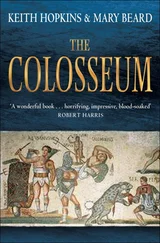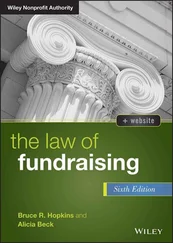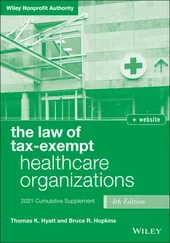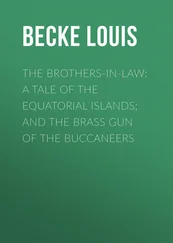Bruce R. Hopkins - The Tax Law of Charitable Giving
Здесь есть возможность читать онлайн «Bruce R. Hopkins - The Tax Law of Charitable Giving» — ознакомительный отрывок электронной книги совершенно бесплатно, а после прочтения отрывка купить полную версию. В некоторых случаях можно слушать аудио, скачать через торрент в формате fb2 и присутствует краткое содержание. Жанр: unrecognised, на английском языке. Описание произведения, (предисловие) а так же отзывы посетителей доступны на портале библиотеки ЛибКат.
- Название:The Tax Law of Charitable Giving
- Автор:
- Жанр:
- Год:неизвестен
- ISBN:нет данных
- Рейтинг книги:5 / 5. Голосов: 1
-
Избранное:Добавить в избранное
- Отзывы:
-
Ваша оценка:
- 100
- 1
- 2
- 3
- 4
- 5
The Tax Law of Charitable Giving: краткое содержание, описание и аннотация
Предлагаем к чтению аннотацию, описание, краткое содержание или предисловие (зависит от того, что написал сам автор книги «The Tax Law of Charitable Giving»). Если вы не нашли необходимую информацию о книге — напишите в комментариях, мы постараемся отыскать её.
The Tax Law of Charitable Giving — читать онлайн ознакомительный отрывок
Ниже представлен текст книги, разбитый по страницам. Система сохранения места последней прочитанной страницы, позволяет с удобством читать онлайн бесплатно книгу «The Tax Law of Charitable Giving», без необходимости каждый раз заново искать на чём Вы остановились. Поставьте закладку, и сможете в любой момент перейти на страницу, на которой закончили чтение.
Интервал:
Закладка:
51 51Priv. Ltr. Rul. 200702031.
52 52IRC § 170(e)(5)(C)(i).
53 53IRC § 170(e)(5)(C)(ii). The term member of the family has the same meaning as that referenced in IRC § 267(c)(2), which is that the family of an individual “include[s] only his [or her] brothers and sisters (whether by the whole or half blood), spouse, ancestors, and lineal descendants.” IRC § 267(e)(4). For purposes of applying this 10 percent limitation, the fact that the private foundation subsequently disposed of qualified appreciated securities is irrelevant (the stock contributed is still subject to the limitation that securities contributed from an estate are not attributable to an individual for purposes of computing the limitation (because an income tax charitable contribution deduction was not claimed or allowable, IRC § 170(e)(1)(B)(ii)), and, in applying the limitation, securities are valued as of the time of their original contribution (i.e., they are not revalued when subsequent contributions are made). Priv. Ltr. Rul. 200112022.
54 54E.g., Priv. Ltr. Rul. 9247018.
55 55IRC § 170(e)(1)(B)(i)(I); Reg. § 1.170A-4(b)(2)(ii).
56 56IRC § 170(e)(1)(B)(i)(II). See § 3.6(c).
57 57For this purpose, a fixture that is intended to be severed from real property is treated as tangible personal property. Reg. § 1.170A-4(b)(2), last sentence.
58 58See § 2.3.
59 59See § 8.2.
60 60See ch. 5.
61 61Reg. § 1.170A-4(b)(3)(i).
62 62Id. The last of these rules is of particular importance in the context of planned giving, where property contributed is often given to a trust, such as a charitable remainder trust (see, in particular, ch. 10).
63 63Reg. § 1.170A-4(b)(3)(ii)(a).
64 64Reg. § 1.170A-4(b)(3)(ii)(b).
65 65Id.
66 66IRC § 170(e)(7)(C).
67 67IRC § 170(e)(7)(B).
68 68IRC § 170(e)(7)(A).
69 69IRC § 170(e)(7)(D).
70 70IRC § 6720B. Other penalties may also apply, such as the penalty for aiding and abetting the understatement of tax liability (IRC § 6701). See § 23.6(b).
71 71See § 3.3.
72 72E.g., Martin v. Machiz, 251 F. Supp. 381 (D. Md. 1966); Magnolia Dev. Corp. v. Commissioner, 19 T.C.M. (CCH) 934 (1960).
73 73This sidestep of the step transaction doctrine has its basis in Palmer v. Commissioner, 62 T.C. 684 (1974), aff'd on another issue, 523 F.2d 1308 (8th Cir. 1975), to which the IRS agreed in Rev. Rul. 78-197, 1978-1 C.B. 83. In Palmer, a gift of stock in a closely held corporation to a charitable organization, followed by a prearranged redemption, was not recharacterized as a redemption between the donor and the redeeming corporation and a later gift of the redemption proceeds to the charity. This was the outcome, although the donor held voting control over both the corporation and the charitable organization. The IRS lost the case because the charity was not legally bound to redeem the stock, nor was the corporation in a position to compel the redemption.
74 74Greene v. United States, 806 F. Supp. 1165 (S.D.N.Y. 1992). This case also involved application of the rules concerning anticipatory assignments of income (see § 3.1(g)). This case was affirmed in an opinion containing an extensive discussion of the step transaction doctrine as it applies in the charitable giving setting. 13 F.3d 577 (2d Cir. 1994).
75 75IRC § 1256(a)(3).
76 76IRC § 170(e)(1)(A). See § 3.4(b).
77 77See § 3.3.
78 78See § 2.1(h).
79 79Greene v. United States, 806 F. Supp. 1165, 1172 (S.D.N.Y. 1992).
80 80Id. at 1173.
81 81Blake v. Commissioner, 697 F.2d 473 (2d Cir. 1982), aff'g 42 T.C.M. (CCH) 1336 (1981).
82 82S.C. Johnson & Son, Inc. v. Commissioner, 63 T.C. 778 (1975).
83 83Id. at 780.
84 84Grove v. Commissioner, 490 F.2d 241, 246 (2d Cir. 1973).
85 85Id.
86 86Id. at 247.
87 87Id.
88 88Humacid Co. v. Commissioner, 42 T.C. 894, 913 (1964). This observation is often quoted (e.g., Grove v. Commissioner, 490 F.2d 241, 246 (2d Cir. 1973); Carrington v. Commissioner, 476 F.2d 704, 708 (5th Cir. 1973); Dickinson v. Commissioner, T.C. Memo. 2020-128 (2020)).
89 89Martin v. Machiz, 251 F. Supp. 381, 390 (D. Md. 1966).
90 90Magnolia Dev. Corp. v. Commissioner, 19 T.C.M. (CCH) 934, 937 (1960). Also Palmer v. Commissioner, 468 F.2d 705 (10th Cir. 1972); Tatum v. Commissioner, 400 F.2d 242 (5th Cir. 1968); Friedman v. Commissioner, 346 F.2d 506 (6th Cir. 1965).
91 91Sheppard v. United States, 361 F.2d 972, 978 (Ct. Cl. 1966). Also Behrend v. United States, 73-1 U.S.T.C. ¶ 9123 (4th Cir. 1972); Fox v. Commissioner, 27 T.C.M. (CCH) 1001 (1968).
92 92See ch. 10.
93 93Priv. Ltr. Rul. 9452020.
94 94Priv. Ltr. Rul. 9452026. An application of the step transaction doctrine, albeit not entailing a charitable contribution, was made available when a court disregarded a series of transactions entered into by a family involving the purchase of ranch properties and subsequent tax-free exchanges of these properties with family-controlled entities (True v. United States, 190 F.3d 1165 (10th Cir. 1999)).
95 95Rev. Rul. 55-410, 1955-1 C.B. 297.
96 96E.g., Priv. Ltr. Rul. 200202034.
97 97E.g., Priv. Ltr. Rul. 200241044.
98 98IRC § 163(a).
99 99Peerless Indus., Inc. v. United States, 94-1 U.S.T.C. ¶ 50,043 (E.D. Pa. 1994).
100 100Id. at 83,174.
101 101IRC § 170(a)(2).
102 102See § 2.4(c).
103 103IRC § 4946 (see Private Foundations ch. 4).
104 104IRC § 4941 (see Private Foundations ch. 5).
105 105Reg. § 53.4941(d)-2(c)(3).
106 106Reg. §§ 53.4941(d)-2(f)(2), 53.4941(d)-2(f)(4), Example (4).
107 107Rev. Rul. 77-160, 1977-1 C.B. 351, 352.
CHAPTER FOUR Timing of Charitable Deductions
§ 4.1 Overview of Law
§ 4.2 Contributions of Money in General
§ 4.3 Contributions of Money by Check
§ 4.4 Contributions of Money by Credit Card
§ 4.5 Contributions of Money by Telephone
§ 4.6 Contributions of Securities
§ 4.7 Contributions of Copyright Interest
§ 4.8 Contributions by Means of Notes
§ 4.9 Contributions by Letters of Credit
§ 4.10 Contributions of Property Subject to Option
§ 4.11 Contributions of Stock Options
§ 4.12 Contributions of Credit Card Rebates
§ 4.13 Contributions of Tangible Personal Property
§ 4.14 Contributions of Real Property
§ 4.15 Contributions of Easements
§ 4.16 Contributions by C Corporations
§ 4.17 Contributions by S Corporations
§ 4.18 Contributions by Partnerships
§ 4.19 Contributions by Means of the Internet
The general rule is that a federal income tax charitable contribution deduction arises at the time of, and for the year in which, the deduction is actually paid. 1 A significant exception to this rule is the body of law concerning the tax deductibility of contributions carried over to a year subsequent to the one in which the gift was made; in this situation, the contribution is actually paid in one year but the allowable charitable deduction arises in, and is treated for tax purposes as paid in, another year. 2 The mere making of a pledge will not result in an income tax charitable deduction. 3 Of course, a mere intent to make a charitable gift does not generate a contribution deduction. 4
§ 4.1 OVERVIEW OF LAW
The matter of the timing of a federal income tax charitable contribution deduction concerns the tax year for which the gift is deductible. To determine this year, the federal tax law follows the concept of title ; that is, the contribution is for the year in which title to the item that is the subject of the gift passes from the donor to the donee. Title to property generally passes when all of the rights to and interests in the property have been properly transferred.
Читать дальшеИнтервал:
Закладка:
Похожие книги на «The Tax Law of Charitable Giving»
Представляем Вашему вниманию похожие книги на «The Tax Law of Charitable Giving» списком для выбора. Мы отобрали схожую по названию и смыслу литературу в надежде предоставить читателям больше вариантов отыскать новые, интересные, ещё непрочитанные произведения.
Обсуждение, отзывы о книге «The Tax Law of Charitable Giving» и просто собственные мнения читателей. Оставьте ваши комментарии, напишите, что Вы думаете о произведении, его смысле или главных героях. Укажите что конкретно понравилось, а что нет, и почему Вы так считаете.












